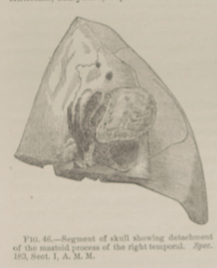Title: B——, John C.
Source text: Surgeon General Joseph K. Barnes, United States Army, The Medical and Surgical History of the War of the Rebellion. (1861–65.), Part 1, Volume 2 (Washington, D.C.: Government Printing Office, 1870), 131.
Civil War Washington ID: med.d1e9573
TEI/XML: med.d1e9573.xml
CASE.—Corporal John C. B——, Co. K, 5th Maryland Volunteers, aged 33 years, was wounded at the battle of Antietam, Maryland, September 17th, 1862. The missile entered the posterior part of the neck, one and one-half inches below the occipital protuberance just forward of the ligamentum nuchæ, passed upward and forward, and emerged above the right ramus of the lower jaw. He was sent to Washington, and admitted to Columbian College hospital on September 20th. No fracture could be discovered. He complained of difficulty in mastication, and there was evidently some injury of the facial nerve. In a few days the wound began to suppurate, and the patient walked about the ward apparently doing well. October 8th, suppuration suddenly ceased. Chills occurred; the frequency of recurrence increased until October 12th, when there was heavy deep breathing, and many symptoms of meningitis. Drowsiness and stupor followed, and coma and death took place October 14th, 1862. At the autopsy it was found that the ball had detached the mastoid process, denuded the occipital and temporal bones of periosteum in the vicinity of the fracture. There was some redness and congestion of the blood vessels, but no traces of inflammation could be found in the brain itself. The specimen was sent to the Army Medical Museum by Surgeon A. Van Derveer, 66th New York Volunteers, and is represented in the adjacent wood-cut, (FIG. 46.) The process is entirely detached at the base, the mastoid cells are opened, of course, but there is no fissuring or other lesion of the inner table and no attempt at repair. Dr. Van Derveer's report does not refer to any impairment of the sense of hearing prior to the supervention of coma.⃰
⃰ See Catalogue of the Surgical Section A. M. M., p. 11, and Circular No. 6, S. G. O., 1865, p. 12. The history of the specimen was procured subsequently to the date of those publications.
